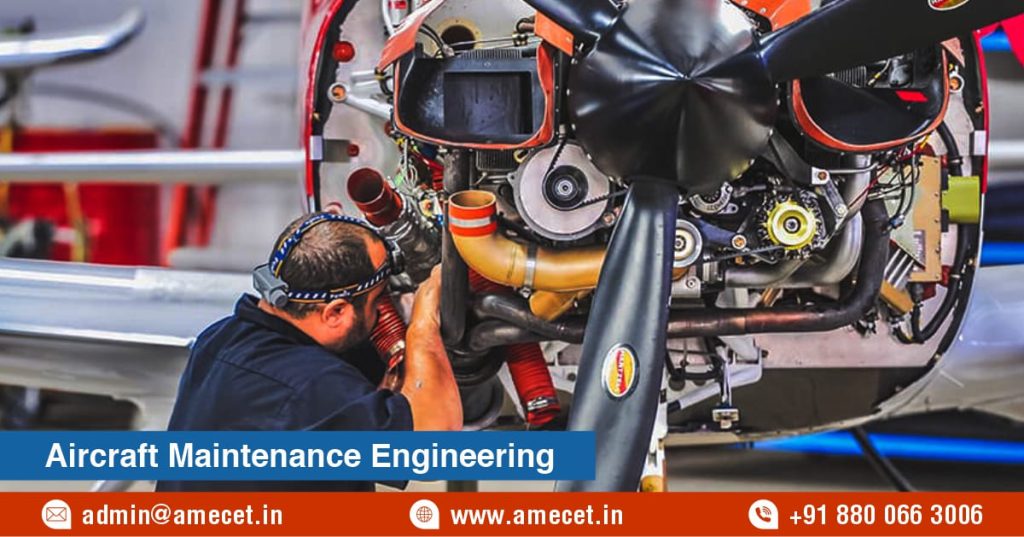Aircraft Maintenance Engineering: Ensuring Aviation Safety
Posted on : 3 July, 2024 12:06 pm
Introduction
- Aircraft Maintenance Engineering (AME) is a critical field ensuring the safety and airworthiness of aircraft. AMEs play a vital role in aviation by conducting regular inspections, performing necessary repairs, and adhering to stringent safety protocols. This guide, “Keeping the Skies Safe: A Guide to Aircraft Maintenance Engineering,” delves into the essentials of AME, including educational requirements, practical training, daily responsibilities, and career opportunities. Aspiring engineers will gain valuable insights into this rewarding profession, where precision, expertise, and dedication keep the aviation industry running smoothly and safely.
Understanding Aircraft Maintenance Engineering
- Aircraft Maintenance Engineering (AME) involves ensuring the safety and functionality of aircraft through routine inspections, repairs, and adherence to strict safety standards. AMEs are responsible for maintaining various aircraft components, from avionics to engines, ensuring compliance with aviation regulations. This field demands technical expertise, attention to detail, and a commitment to keeping aircraft operational and safe for flight.
Basics of Aircraft Maintenance Engineering
- Aircraft Maintenance Engineering (AME) focuses on the upkeep and repair of aircraft to ensure safety and efficiency. AMEs perform routine inspections, diagnose and fix issues, and comply with aviation regulations. Their expertise spans various systems, including avionics, engines, and airframes, making them crucial for maintaining the operational readiness and safety of all types of aircraft.
The Role of an Aircraft Maintenance Engineer
- Aircraft Maintenance Engineers (AMEs) ensure aircraft safety and performance through meticulous inspections, routine maintenance, and repairs. They diagnose mechanical and technical issues, maintain avionics, engines, and structural components, and ensure compliance with aviation safety regulations. AMEs play a crucial role in preventing accidents and ensuring that aircraft are airworthy, reliable, and ready for flight operations.
Education and Training
- Aspiring Aircraft Maintenance Engineers (AMEs) need a strong foundation in mathematics and science, typically obtained through secondary education. They must complete an accredited AME program, which combines classroom instruction with hands-on training. Certification and licensing are essential, requiring candidates to pass rigorous exams and accumulate practical experience through apprenticeships or internships in the aviation industry.
Specialized Areas in AME
- Aircraft Maintenance Engineers (AMEs) can specialize in various fields, including avionics, which focuses on electronic systems; powerplant, dealing with engine maintenance and repair; and airframe, concerning the aircraft’s structural components. Each specialization requires targeted training and expertise, allowing AMEs to address specific maintenance needs and enhance the safety and performance of different aircraft systems.
Tools and Technologies
- Aircraft Maintenance Engineers (AMEs) utilize advanced tools and technologies, including diagnostic equipment, digital inspection devices, and specialized software for maintenance tracking. Modern innovations like borescopes, ultrasonic testers, and computerized maintenance management systems (CMMS) enhance precision and efficiency. Staying updated with the latest tools and technologies is crucial for AMEs to ensure aircraft safety and operational readiness.
Career Path and Opportunities
- Aircraft Maintenance Engineers (AMEs) have diverse career paths in aviation, including roles in airlines, maintenance repair organizations (MROs), aerospace manufacturing, and government agencies. Opportunities exist globally, with demand driven by fleet expansion, regulatory requirements, and technological advancements. AMEs can specialize in specific aircraft types or systems, pursue managerial roles, or transition into related fields like aviation safety or quality assurance.
Conclusion
- Aircraft Maintenance Engineering (AME) stands as a cornerstone of aviation safety and reliability, ensuring that aircraft operate at peak performance and adhere to rigorous safety standards. Aspiring AMEs embark on a journey requiring technical expertise, dedication to continuous learning, and a commitment to precision. By mastering the complexities of aircraft systems, navigating regulatory landscapes, and embracing advancements in technology, AMEs contribute significantly to the seamless operation of the aviation industry worldwide. Embrace the challenges and opportunities in AME to forge a fulfilling career safeguarding the skies and advancing aviation safety for future generations.

